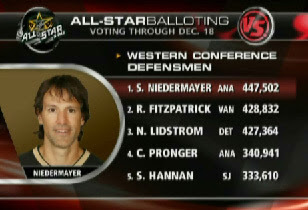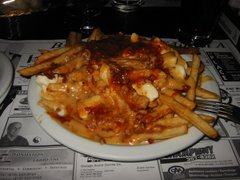11/29/06
SportsBlurb.com articleA few weeks ago I wrote an article where I pointed out that only a short way into the season there already had been some talk about who the leading Hart candidates were. While cautioning that, obviously, the bulk of the season was still to be played, a number of names weren’t being talked about that should emerge as MVP contenders, including Jarome Iginla and Thomas Vanek. While I still stand by those selections, after writing the article I reflected on it a bit and wondered why post-season sports awards are taken so seriously. Like anyone else, I get caught up in discussing who is the best at any particular position or in the entire league – that’s much of the fun of following sports – but in the end, awards are just a select group of newspaper writers (with flaws and biases, like anyone else) who vote on who they think is the “best” and the winner of that poll is awarded the official MVP, Norris, Gold Glove, or whatever.
Back in the days when the NHL consisted of literally only a handful of teams, beat writers were able to see each opponent up to 14 times per season and could get a pretty good idea of who the best players were. In contrast it seems logically impossible to be a voter today and sensibly evaluate players on all 30 teams to determine who the best is in any particular area (barring absurd seasons like a Wayne Gretzky 200+ point year) – how can a Northeast writer who might see Iginla or Chris Pronger at most once during the year make an accurate determination on whether they have had a better year than Jaromir Jagr or Zdeno Chara? They obviously can’t, and therefore earned reputations, deserving or not, play a huge part in who wins these awards.
All too often, the player that either has “The Name”, or is “The Story” of the year will have a huge leg up on winning the award while the more deserving player, who for whatever reason doesn’t get the press, or maybe even gets negative press, ends up in the pack of also-rans. To use an extreme example from another sport, baseball’s Gold Glove awards, which recognizes the best fielder at a particular position, are a joke – once you win it, it’s essentially yours to lose. For example, in the 50 years of the award, there have only been 11 different American League pitchers, and 14 National Leaguers, that have won it. And the most high-profile award, the MVP, this year went to two very good players – Ryan Howard and Justin Morneau – who were not the best players in each league (and in Morneau’s case, not even the best player on his own team), but instead were great stories on two teams who had surprising runs. In the NHL, the award for best defenceman in the league each year is the Norris Trophy. The Norris has seen its share of players who had a lock on the award, from Doug Harvey to Pierre Pilote to Bobby Orr (with eight straight Norris trophies), and while today there’s not a single-player stranglehold on the trophy there are still perennial favourites in Nicklas Lidstrom, Pronger, and Scott Niedermayer (and to a lesser extent contenders Chara and Bryan McCabe) that will always get the benefit of the doubt and therefore the longer look at awards time. In no way are those players mentioned not deserving of their accolades, but it seems a shame that other equally-deserving talents aren’t given as much exposure.
Rather than coming up with a huge list of underrated defencemen, I present three players to watch over the rest of the season; relatively unknown defensive names in terms of national press but this season are deserving of more love from the media – and maybe award voters come April.
Brian Campbell – Buffalo Sabres
The idea that Norris and Campbell could be in the same sentence (and not referring to the old division and conference names) would have been laughable a few months ago and downright ridiculous a year or more ago. Brian Campbell was an offensive wizard in the OHL with the Ottawa 67’s in the late 1990s, and did in fact win the OHL’s Norris equivalent (Max Kaminsky Trophy) in his final year (1999) when the 67’s won the Memorial Cup. Yet his first five years with the Sabres were spent either bouncing between Buffalo and their AHL franchise in Rochester or being periodically benched. His defensive play was not NHL-caliber and his offensive skills were not enough to outweigh his deficiencies. As last season progressed, however, Campbell began to fill a bigger role for the Sabres as they instituted a more high-tempo style of play, and now watching him this year he’s become a nearly completely different player. Not with regards to his offence – his 17 points is tied for seventh among all defencemen – but his overall game. Maybe it started with the notorious hit on Philadelphia’s R.J. Umberger in the playoffs last year, but his confidence is striking; comparing his defensive play to even a year ago is like night and day – his greatest strength is carrying the puck (many times utilizing his spin-o-rama move – of course all credit is due to the original Master, Denis Savard - leaving opponents grasping for air) but now he seems to be less-likely to be caught out of position as he had in the past; his pinches are more intelligent and perhaps as a result his +14 rating is fourth in the entire league among all skaters (he was a -14 last year and has never been a plus player). Since Buffalo’s top defensive pairing of Henrik Tallinder and Toni Lydman have gone down to injury, coach Lindy Ruff has placed Campbell in a leading role and he has succeeded, averaging a Pronger-like 29 minutes per contest over the past eight games while staying a +2 over the same span, showing that his play against the opponents’ top forwards has not suffered. He even has 48 blocked shots, tops on the Sabres. Campbell has become perhaps the vital cog on the back end of the Sabres’ offensive machine and can now be considered among the most exciting NHL defencemen, if not one of the best.
Sheldon Souray – Montreal Canadiens
Another who previously couldn’t have been listed on any “top defencemen” list unless it was followed by some phrase by Triumph the Insult Comic Dog, Sheldon Souray is having a very solid season, enough to not only quiet his legion of critics but garner support as one of the best in the league this year. Drafted 12 years ago by New Jersey, his play had been markedly inconsistent at best and through his first six years in NJ/Montreal, his career high was 11 points. Over the last two years though, Souray has found his long-dormant offensive game, with 35 and 39 points respectively, and this year is fifth among all defencemen with 18 points in 22 games. Although he’s only a -2, he is being challenged by facing more top forwards, and his success against the better teams is a strong mark in his favour - last week in Buffalo he was matched up against Daniel Briere’s line, was a +2 and more importantly ended up with the game-winner in OT. The week before against the Lightning he was matched up against the Brad Richards line and ended up with two goals. A much different player than the dynamic Campbell, Souray is much more a player who utilizes his large frame (6’4”, 225lbs) and big shot. That booming shot has always been a big weapon for him, but before this season he’s rarely been able to channel that into results on the scoresheet – this year he has used it to help him notch nine goals, tops among all defencemen this year. Montreal has had a quietly strong campaign thus far, sitting a strong third in the Northeast, only a point (with three games in hand) behind the hated Leafs, and their stalwart defence has only allowed 61 goals, good for third in the conference. Much credit goes to Cristobal Huet but the unknown defence deserves much credit (89.6% penalty killing rate, third in the league) and Souray has played an important part.
Kimmo Timonen – Nashville Predators
In another market – say, Detroit or Toronto – one with a bit more hockey focus and perhaps some more playoff experience, Kimmo Timonen would be a household name. He’ll just have to be content with being the top defensemen on the best unknown team in the NHL. This eight-year NHL veteran has been steadily improving his offensive output over the years, peaking at 50 points last year and was their second leading scorer (four points) in last year’s quick playoff exit. With four straight years of 40+ points, one would expect him to be more well-known but his home team and the fact that he’s only played in 11 playoff games (none past the first round) doubtless contribute to his relative anonymity. This year the expectations on Nashville are as high as they’ve ever been, and with those expectations came more responsibility for their veteran leader. Timonen was named team captain before the season and at the follow-up press conference expressed his own expectations on challenging for the Stanley Cup. Although his offence has been solid for years, his defensive game had been average, but this year his +6 would already constitute a career high. He averages nearly 24 minutes per night, and has become their power play quarterback with nine points – both tops on the team, and is constantly faced up against opponents’ top players – last week’s 6-2 rout of the rival Wings saw Timonen playing multiple roles, shutting down three Detroit lines while contributing to three power play goals. Nashville is currently leading the Central division and – like last season – will be in a two-team race with Detroit the rest of the way. They expect nothing less than a decent showing in the playoffs this time and with Timonen’s leadership over an otherwise very young defensive corps, a nice playoff run will increase his name value around the league.
A few other defensive names that are worth noting are Nashville’s Shea Weber, Washington’s Brian Pothier, Montreal’s Andrei Markov, and Carolina’s Mike Commodore (although known due to his Cup victory…and his hair, he’s quietly having his best season by a long shot). I was loath to bring up Toronto’s Tomas Kaberle, not because he’s not having an outstanding year (he is) but Toronto doesn’t need the extra press. ;-) As with my previous MVP article, this isn’t at all meant to be a comprehensive list, nor is this meant to say that awards are useless – they are fun and great to have fun with and debate. It would just be nice to hear a wider range of potential candidates throughout the year, as with 30 teams there is an amazing array of talent in today’s NHL, and beyond the “big three” of Lidstrom, Pronger, and Niedermayer, there are dozens of great defencemen deserving of their time in the limelight.
…and for the record, baseball’s MVP awards should have gone to Albert Pujols and Johan Santana. But then again, I don’t care….right?
Feedback can be sent to robaquino@sportsblurb.com.

